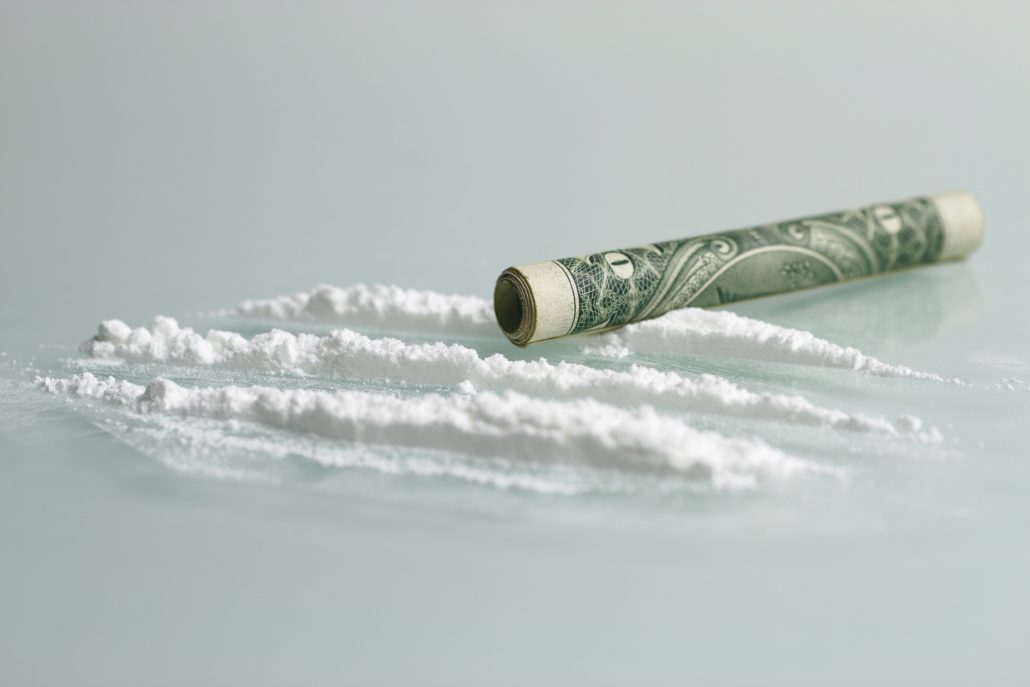by Justin Mckibben | Nov 7, 2017 | Cocaine, Drug Abuse, Recovery, Stimulants

While the opioid crisis in America has reached public health emergency proportions, we still have to remember that there are a lot of other extremely dangerous drugs out there. Cocaine is a drug that has been around for a very long time, but with the rise in heroin and prescription drug abuse, people may have this idea that cocaine is no longer a real threat.
However, cocaine is still very dangerous and very prevalent around the world and here in the United States.
So how well do you know this drug? What do you know about its history? Do you know about the most common health risks?
Here are 25 facts about cocaine you probably don’t know.
Random History
-
Karl Koller (1857-1944)
This Austrian ophthalmologist experimented with cocaine as an anesthetic. The most infamous accounts are of Koller applying the drug to his own eye and then pricking it with needles.
-
Nervous Stimulant
Cocaine is the most powerful central nervous stimulant found in nature. The drug often gives users feelings of alertness, energy and even power.
-
Commercial Cocaine
In 1885, a U.S. manufacturer sold cocaine commercially. They advertised that cocaine would “make the coward brave, the silent eloquent, and render the sufferer insensitive to pain.”
Side note- The manufacturer even included a syringe in the packaging.
-
Drugged on the Job
According to some historians, white business owners in the early 1900s would encourage their African-American employees to use cocaine in order to boost their productivity.
-
First Addicted Physician
In 1884, famous American physician William Stewart Halsted performed the first surgery using cocaine as an anesthetic.
Side note- he shortly afterward became the first cocaine-addicted physician on record. Surprising?
-
Powdered Money
According to one study, trace amounts of cocaine can be found on 4 out of every 5 dollar bills. However, cocaine is a fine powder and is easily spread around, meaning the bill wasn’t necessarily used as a snorting straw.
-
Nazi Addicts
Historians say that Hitler was addicted to cocaine, among many other drugs including methamphetamines. Nazis often used drugs as a means of stimulation. Many believe all those stimulants helped ignite his ranting paranoia.
Prevalence
-
Second Most Popular
Cocaine is the second most commonly used illicit drug in the United States. The first is marijuana.
-
Emergency Visits
In 2004-2007 cocaine overdose caused 31% of visits to the emergency room.
-
First Timers
Every day, 2,500 Americans try cocaine for the first time.
-
Worldwide
Over 200 million people use illegal drugs worldwide. 21 million of those people use cocaine.
-
American Addiction
Even though the United States only makes up less than 5% of the world’s population, the country consumes approximately 37% of the world’s cocaine.
-
Illicit Industry
The illicit cocaine industry earns between $100 and $500 billion each year.
-
Scotland Snorts
Scotland has the highest cocaine use out of any other country in the world. One out of every 40 Scots uses cocaine, which is approximately 2.4% of the population.
-
Babies Born Addicts
Every year in the United States more than 400,000 babies are born already addicted to cocaine.
Health Risks
-
Fast-Acting Addiction
An estimated 10% of all people who begin using cocaine will immediately progress to serious, heavy.
-
Sharing is Hurting
Sharing straws to sniff cocaine can actually spread several blood-borne diseases, including hepatitis C.
-
Mental Health
Cocaine users tend to have higher rates of certain mental health conditions, including:
When compared to the general population.
-
Perfect for Heart Attacks
Come describe cocaine as the “perfect heart attack drug” because it causes so many harmful effects, including:
- Increased blood pressure
- Stiff arteries
- Thickening of heart muscle walls
Even worse is that these irregularities persist long after the effects of cocaine have worn off, even for those who aren’t chronic users.
-
Bruxism
Chronic cocaine use can cause a condition called bruxism, which is grinding of the teeth involuntarily.
-
Drug-Induced Decay
Cocaine frequently causes dehydration and dry mouth. This leads to many users having less saliva in their mouth, which can then lead to tooth decay.
-
The Nose No’s
Cocaine can also destroy the cartilage separating a person’s nostrils after continued use.
-
Deadly Influence
The direct pharmacological effects of the cocaine are often only credited with 1/3 of the deaths associated with cocaine use. The majority of deaths in connection with cocaine are by:
- Homicide
- Suicide
- Motor vehicle collisions
Meaning a lot of people die as a result of the mind-altering properties of cocaine and risk behaviors associated with the drug.
-
Lethal Mix
Consuming cocaine with alcohol is one of the deadliest drug combinations there is.
Now you may be wondering… what is the last fact going to be? You might get through this list knowing less than you expect about the powerful illegal stimulant…
NUMBER 25…
You can quit because there is help for you. Cocaine addiction can be crippling and feel impossible to overcome. But with safe medical detox, followed by effective and holistic treatment options, you can build a lasting foundation for recovery from cocaine addiction.
Palm Healthcare Company takes pride in offering comprehensive and innovative treatment options to help individuals create a personalized recovery plan. If you or someone you love is struggling, please call toll-free now. We want to help.
CALL NOW 1-888-922-5398
by staff | Jul 19, 2017 | Addiction, Cocaine, Detox, Drug Abuse, Inpatient Treatment, Withdrawal

Cocaine is a strong stimulant categorized as a Schedule II controlled substance, commonly abused as a recreational drug. While this infamous substance has been illegal for recreational use for decades, it hasn’t lost too much of its popularity on the illicit market. But do people really know how dangerous this drug is?
Cocaine not only harms the individual physically, but also harms their psychological and neurological health. Not to mention their personal and professional lives. So what are the side effects of cocaine?
What are the Side Effects of Cocaine: Short Term
This stimulant creates an intense but short-lived feeling of euphoria that is often immediately followed by some uncomfortable side-effects. This is typically why people who use the drug experience such intense cravings for more. Ultimately, there is an assortment of short term side effects of cocaine, including:
- Loss of appetite
- Increased heart rate
- Increased blood pressure
- High body temperature
- Contracted blood vessels
- Increased rate of breathing
- Dilated pupils
- Disturbed sleep patterns
- Nausea
- Hyperstimulation
- Bizarre, erratic, sometimes violent behavior
- Hallucinations
- Hyperexcitability
- Irritability
- Intense euphoria
- Anxiety and paranoia
- Depression
- Intense drug craving
- Panic and psychosis
- Convulsions
- Seizures and sudden death
That last one is especially important because this is something most people fail to realize about cocaine. The reality is, no matter how much of the drug is used or how often, cocaine can cause a stroke, heart attack, seizure or respiratory failure resulting in death with even the first use of a seemingly insignificant amount.
What are the Side Effects of Cocaine: Long Term
Like any other substance put into the body over an extended period of time, a powerful drug like cocaine can cause long term side effects. Some of these long term side effects are directly correlated to the method of use such as:
- Sniffing cocaine can damage tissues in nose, causing the loss of the sense of smell, sniffling, nosebleeds and hoarseness
- Injecting cocaine can cause infectious diseases and abscesses, or allergic reactions and collapsed veins
- Smoking cocaine can cause respiratory failure
Other more general long term side effects of cocaine include:
- Permanent damage to blood vessels
- Malnutrition
- Weight loss
- Severe tooth decay
- Hallucinations
- Sexual problems
- Reproductive damage and infertility (for both men and women)
- Disorientation
- Apathy
- Exhaustion
- Irritability and mood disturbances
- Increased frequency of risky behavior
- Delirium or psychosis
- Severe depression
- Tolerance and addiction (even after just one use)
- Liver, kidney and lung damage
What are the Side Effects of Cocaine: Health Risks
Cocaine is extremely destructive to the body. Just a few examples of how the side effects of cocaine ravage the body include:
- Heart health
Cocaine can impact you heart health in a number of ways. The drug causes inflammation of the heart muscle, increases heart rate and increases blood pressure while constricting the arteries supplying blood to the heart. This can lead to heart attack, even in young people without heart disease.
Cocaine can also trigger a deadly abnormal heart rhythm called arrhythmia.
- Lungs
The most common way cocaine is used is through snorting because the method sends the drug quickest to the brain to be absorbed. But snorting cocaine can cause a variety of serious lung issues, like:
- Asthma
- Bronchitis
- Edema
- Hemorrhage
- Infection
Chronic cocaine users often have shortness of breath, coughing, wheezing, and chest pain.
- Brain
The side effects of cocaine on the brain can constrict blood vessels, resulting in strokes. Again, it can happen with even young people without other risk factors for strokes. Cocaine’s impact on the brain also causes seizures and can lead to bizarre or violent behavior. Chronic users can even experience bleeding inside the brain and swelling of the walls of the cerebral blood vessels.
Some studies have indicated that cocaine use also harms the gray and white matter in the brain, impairing cognitive functioning.
- Lungs and respiratory system
Snorting cocaine damages the nose and sinuses. Regular use can cause nasal perforation. Gastrointestinal tract. Cocaine constricts blood vessels supplying the gut. The resulting oxygen starvation can cause ulcers, or even perforation of the stomach or intestines.
- Kidneys
Long term use of cocaine can cause sudden, overwhelming kidney failure through a process called rhabdomyolysis. Cocaine is also nephrotoxic, meaning users will do damage to the kidneys simply by introducing the substance into the body. In people with high blood pressure, regular cocaine use can accelerate the long-term kidney damage caused by high blood pressure.
The metabolite of cocaine called Cocaethylene also damages kidneys.
What are the Side Effects of Cocaine: Withdrawal Symptoms
Common withdrawal symptoms may include:
- Agitation and restless behavior
- Depression
- Anxiety
- Chills
- Tremors
- Nerve pain
- Muscle aches
- Intense cravings
- Fatigue
- Generalized discomfort or uneasiness
- Increased appetite
- Vivid and unpleasant dreams
- Slowing of activity
All of the side effects of cocaine indicate that a safe medical detox supported by experienced professionals in the field of addiction treatment can be a pivotal turning point. While detoxing off of any drug can be a frightening concept for those who do not know what to expect, it often means the difference between a life worth living and suffering from a fatal illness.
Addressing the withdrawal symptoms and side effects of cocaine addiction is an important piece of getting better and getting your life back. All you have to do is take the first step. If you or someone you love is struggling, please call toll-free now.
CALL NOW 1-888-922-5398



